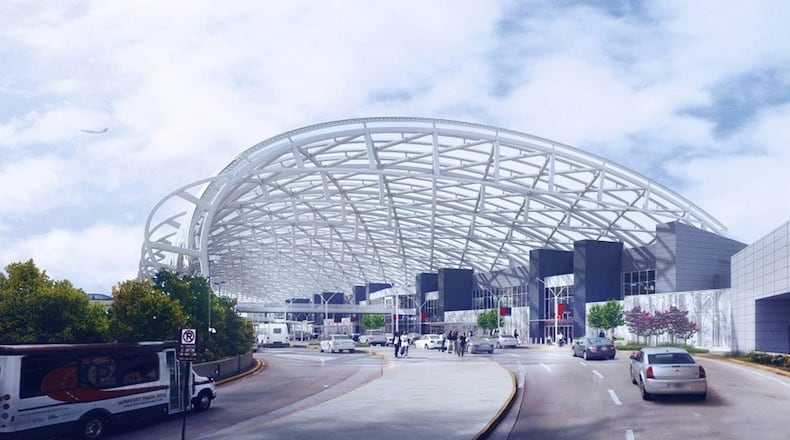In the City Too Busy to Hate, perhaps it’s fitting that the airport is too busy to worry about architectural attractiveness.
At least that’s the rep Hartsfield-Jackson International’s domestic terminal has earned over the decades.
But officials at the world's busiest airport hope that two massive, multi-million dollar canopies will brighten the domestic terminal's visage — with the help of more than 3,600 multi-colored lights.
The airport canopies will “become the next architectural icon for the City of Atlanta,” the airport said in an announcement.
Construction of the first canopy at the Terminal North curbside is disrupting traffic from late evening into the early morning hours, but city and airport officials say it will all be worth it.
According to Vanderbilt University professor and history of art department chair Kevin D. Murphy, “having a very unattractive airport, as Atlanta now does, can only create negative feelings about the city, which could have an economic impact as people choose to travel elsewhere.”
Atlanta isn’t the only city with this problem. U.S. airport design has “a lot of catching up to do with the rest of the world,” says Max Hirsh, an expert on the subject and author of “Airport Urbanism.” Airports in Asia and the Middle East have earned props with more innovative approaches.
With airport designs like Washington’s Dulles and New York’s John F. Kennedy International’s TWA terminal, “we used to be at the forefront of architectural innovation,” according to Hirsh.
The TWA terminal at JFK, now being redeveloped into a hotel, and the main terminal at Dulles "are iconic because the forceful design element is not something appended to a utilitarian building, but rather it is the building," Murphy noted. Both were designed by architect Eero Saarinen.
Without tearing down the entire Atlanta airport terminal, “it would be impossible to achieve that kind of impact,” Hirsh said.
But the Atlanta airport canopies “have a soaring quality that suggests flight, in its best sense,” according to Murphy. “With the amount of air travel to and from Atlanta, the architectural distinction — or poverty — of its airport is going to have a tremendous impact on impressions of the city overall.”
The Terminal North canopy is expected to be completed this fall and the Terminal South canopy in fall 2019. Airport officials began testing the canopy lighting system over the summer.
The canopy can be lit in different colors for occasions, such as red and black for a Falcons victory, green for Earth Day, or red white and blue for Independence Day, airport officials said.
The cost for construction of the canopies makes up the bulk of a $265 million construction contract for terminal improvements.
The design of Atlanta City Hall prompted objections about unnecessary expense when it was built in the 1930s, according to Murphy, as noted in his book with co-author Lisa Reilly, “Skyscraper Gothic.”
“Strictly speaking, the function of a city hall could have been accommodated in a much simpler and less expensive building, but Atlanta’s leaders believed that an architecturally ambitious city hall represented the city’s economic centrality to the New South,” said Murphy. “They also believed that having an architecturally distinguished building would suggest that Atlanta was as modern and cultured as other cities well-known for skyscrapers, especially Chicago and New York.
“With the renovation of its airport, Atlanta has the opportunity not only to improve its functionality, but also to improve the impression it makes on the many, many people who travel through it every day,” Murphy added.
Justis Brogan, senior project manager of the canopy project, said the canopies will provide a shield from the weather “and create a curbside atmosphere that welcomes everyone to Atlanta.”
Curbside street lights shine through the canopy and illuminate it. But the lights installed inside the canopy will have the added ability to produce red, green or blue light — or any combination thereof. That means there are infinite colors possible, but the airport has narrowed that down to a dozen different colors it will choose from.
The plastic roof covering is made of ethylene tetrafluoroethylene, similar to the material used in the roof of the Mercedes-Benz stadium.
The LED light fixtures are “extremely long-lasting,” perhaps 15 to 20 years, Brogan said.
“The lights really add a great feature to the canopy and turn it into a one-of-a-kind structure that’s unique and adaptable,” Brogan said.
Hirsh called the canopies a “step in the right direction.”
“Terminal redevelopment projects like the one at Hartsfield offer U.S. airports an opportunity to reinvent themselves as places where travelers enjoy spending time, as opposed to being places that they dread,” he said.
About the Author
Keep Reading
The Latest
Featured



